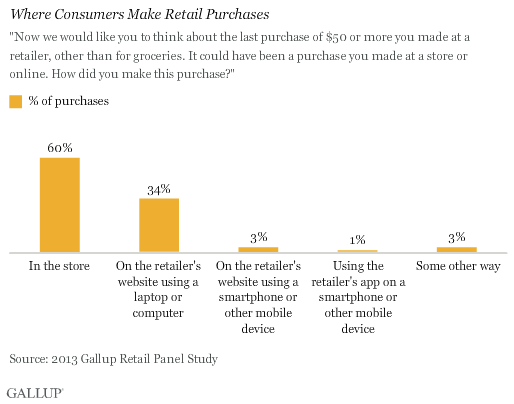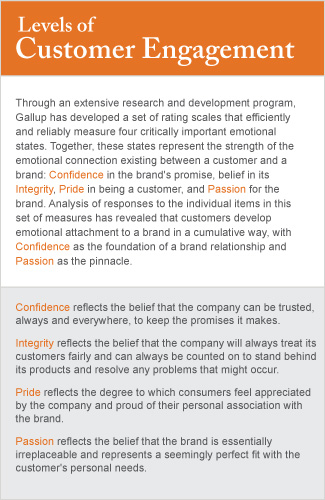Neglecting the mobile storefront creates a serious risk to the customer experience.
This article is part of a weeklong series analyzing how mobile technology is affecting politics, business, and well-being. See more articles on Gallup.com
With the release of the first iPhone in 2007, a new customer purchasing channel was born -- the mobile marketplace. To date, however, this marketplace has yet to live up to its potential.
Few non-technology purchases occur on a mobile device or a smartphone, despite the near ubiquity and use of such devices; according to one report, people check their mobile devices 150 times a day. The gap between mobile device usage and actual mobile purchases represents an enormous opportunity for businesses that are willing to embrace their brand and engage their mobile customers.
Building mobile customer engagement
According to Gallup's research, the vast majority of purchases of $50 or more are made either in a store (60%) or on a website using a computer (34%). Only 4% of purchases of $50 or more are made on a smartphone or other mobile device.

Most consumers aren't opposed to making a purchase on a mobile device. About half of the survey respondents (49%) had made a purchase using a smartphone, tablet, or other mobile device, while 50% had not. And about one-quarter of respondents (24%) said they were extremely likely to make a mobile purchase in the next year, while the same percentage (24%) said they were not at all likely to make a mobile purchase in the coming year. Predictably, younger consumers are much more likely than older consumers to make a mobile purchase in the coming year.

As consumers become more comfortable making purchases on mobile devices, savvy retailers will be looking for ways to take their money. So how can companies get customers to purchase more -- and more often -- using their mobile devices?
The short answer is that consumers first must be engaged with your brand. Too often, mobile apps and website interfaces offer transactional sales experiences that don't build any real connection to a company's brand identity and thus do little to drive customer engagement. Customer engagement, which strongly predicts a person's spending habits, is a unique combination of Confidence in a brand's promise, belief in its Integrity, Pride in being a customer, and Passion for the brand. (See sidebar "Levels of Customer Engagement.")

Most companies' mobile apps or mobile websites rarely attempt to address the crucial elements of customer engagement. When we ask people why they're not comfortable with making a smartphone purchase, for example, 29% report that they don't trust the security of the process -- a clear sign that that the mobile shopping experience is not building Confidence or Integrity. And 30% prefer the in-store shopping experience -- indicating that the mobile shopping experience is not building Pride or Passion.
The good news is that companies that can create an engaging mobile shopping experience are likely to receive significant business advantages. Customers who are strongly engaged with a company's product, service, or brand spend significantly more than less-engaged customers. Gallup's analysis shows that fully engaged customers deliver a 23% premium over average customers in share of wallet, profitability, revenue, and relationship growth. Successfully engaging customers in every channel -- mobile included -- can significantly increase your company's per-person profitability.
Creating a new revenue channel
Companies that create an engaging mobile storefront can also gain a competitive advantage over their peers. For example, our analysis indicates that banking customers aren't replacing their in-store or online banking with mobile platform use; they're simply adding mobile usage. This suggests that if companies can create an engaging mobile storefront, they can generate a new revenue channel that does not compete with their existing revenue channels. This is equivalent to striking business gold.
On the other hand, neglecting the mobile storefront creates a serious risk to the customer experience. 优蜜传媒has found that many customers in different industries use in-person and mobile channels, and the experience must be consistently good with both. Our analysis of banking channels shows that engagement scores plummeted by 31 percentage points when customers were satisfied with the branch experience but dissatisfied with the mobile banking experience -- compared with the engagement scores of customers who were satisfied with both the branch and mobile experience. In other words, giving a less-than-exemplary mobile experience to customers who are satisfied store users will dramatically and negatively affect customer engagement. This is especially troubling because people who use both channels are often a company's most valuable customers.
Creating a mobile platform that enhances rather than detracts from customer engagement is just the first step in building a mobile storefront that complements the in-store or online experience. You also need a deep understanding of your customers' preferences, intentions, shopping tendencies, and purchasing behavior. What do your customers want or need just from your company's storefront or just from its mobile platform -- and what do they want from both? What features should you build into the mobile experience to increase the chances that customers come to your company the next time they need your product or service?
And here's another key point: Most companies understand that their mobile experience must be as good as or better than that of their industry competitors. But they may not realize that consumers expect their mobile experience to be outstanding compared with mobile experiences across other industries as well. For example, Gallup's analysis shows that Amazon.com users are less satisfied with their mobile banking apps than mobile banking users who have not recently used Amazon, even when comparing the same mobile banking apps.
And Amazon isn't the only company out there with such a good digital experience that it lowers the user satisfaction of other companies' mobile platforms. Keep in mind that your company isn't just competing against other companies for mobile sales -- you're competing to get consumers' attention in the first place. Consumers, for example, are comparing their experience using your mobile app to the experiences all the other apps they use provide, not just apps with the same offerings or in the same industry. Your customer experience can appear subpar compared with all the apps on a consumer's phone, so look closely at your competitors and other industries to inform your mobile experience.
Build your brand
Building customer engagement through your mobile storefront begins and ends with your brand. If your mobile storefront is disconnected from your brand or brand promise, you'll not only miss out on mobile sales, you also could alienate customers from making future purchases in-store or online. To ensure that your desired brand experience carries through all your company's sales channels, we recommend that you:
- Question your brand and brand promise. Do you know what your brand represents? Do your employees? Do your customers?
- Assess how well your current mobile storefront exemplifies your brand. Does your mobile storefront represent your company, or is it the same storefront that your competitors offer with a different logo? Do your mobile interactions support or detract from your brand promise?
- Compare your mobile storefront to your competitors'. How does your mobile experience compare? Does your brand and how you execute your brand experience stand out in comparison with that of your competitors?
- Make sure that the employees who own the mobile storefront are empowered to deliver on your brand. Are they completely aligned with your brand promise? Can these employees execute on the core elements of that promise? What is holding them back from creating a truly transformational and engaging customer experience?
- Identify your unique drivers of customer engagement, and make sure they are on your mobile storefront. What are the experiences that are completely unique to your business that most engage customers? How can those experiences be replicated on a mobile device or smartphone?
Connecting your brand to your mobile touchpoints is not an easy undertaking, but it is worthwhile. The gap between what your mobile storefront could do -- and what it currently is doing -- is an opportunity just waiting to be tapped.
